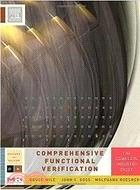| FindBook |
有 1 項符合
COMPREHENSIVE FUNCTIONAL VERIFICATION: THE COMPLETE INDUSTRY CYCLE的圖書 |
 |
COMPREHENSIVE FUNCTIONAL VERIFICATION: THE COMPLETE INDUSTRY CYCLE 作者:WILE 出版社:ACADEMIC PRESS 出版日期:2005-05-26 |
| 圖書館借閱 |
| 國家圖書館 | 全國圖書書目資訊網 | 國立公共資訊圖書館 | 電子書服務平台 | MetaCat 跨館整合查詢 |
| 臺北市立圖書館 | 新北市立圖書館 | 基隆市公共圖書館 | 桃園市立圖書館 | 新竹縣公共圖書館 |
| 苗栗縣立圖書館 | 臺中市立圖書館 | 彰化縣公共圖書館 | 南投縣文化局 | 雲林縣公共圖書館 |
| 嘉義縣圖書館 | 臺南市立圖書館 | 高雄市立圖書館 | 屏東縣公共圖書館 | 宜蘭縣公共圖書館 |
| 花蓮縣文化局 | 臺東縣文化處 |
|
|
- 圖書簡介
One of the biggest challenges in chip and system design is determining whether the hardware works correctly. That is the job of functional verification engineers and they are the audience for this comprehensive text from three top industry professionals.
As designs increase in complexity, so has the value of verification engineers within the hardware design team. In fact, the need for skilled verification engineers has grown dramatically--functional verification now consumes between 40 and 70% of a project's labor, and about half its cost. Currently there are very few books on verification for engineers, and none that cover the subject as comprehensively as this text.
A key strength of this book is that it describes the entire verification cycle and details each stage. The organization of the book follows the cycle, demonstrating how functional verification engages all aspects of the overall design effort and how individual cycle stages relate to the larger design process. Throughout the text, the authors leverage their 35 plus years experience in functional verification, providing examples and case studies, and focusing on the skills, methods, and tools needed to complete each verification task. Additionally, the major vendors (Mentor Graphics, Cadence Design Systems, Verisity, and Synopsys) have implemented key examples from the text and made these available on line, so that the reader can test out the methods described in the text.
* Comprehensive overview of the complete verification cycle
* Combines industry experience with a strong emphasis on functional verification fundamentals
* Includes industry examples and real-world case studies - 目次
Part I: Introduction to Verification
Chapter 1: Verification in the Chip Design Process
1.1 Introduction to Functional Verification
1.2 The Verification Challenge
1.3 Mission and Goals of Verification
1.4 Cost of Verification
1.5 Areas of Verification beyond the scope of this book
1.6 The Verification Cycle: A Structured Process
1.7 Summary
1.8 Exercises
Chapter 2: Verification Flow
2.1 Verification Hierarchy
2.2 Strategy of Verification
2.3 Summary
2.4 Exercises
Chapter 3: Fundamentals of Simulation Based Verification
3.1 Basic Verification Environment: A Test Bench
3.2 Observation Points: Black-box, White-box and Grey-box verification
3.3 Assertion Based Verification - An overview
3.4 Test benches and Testing Strategies
3.5 Summary
3.6 Exercises
Chapter 4: The Verification Plan
4.1 The Functional Specification
4.2 The Evolution of the Verification Plan
4.3 Contents of the Verification Plan
4.4 Verification example: Calc1
4.5 Summary
4.6 Exercises
Part II: Simulation Based Verification
Chapter 5: HDLs and Simulation Engines
5.1 Hardware Description Languages
5.2 Simulation Engines - Introduction
5.3 Event-Driven Simulation
5.4 Improving Simulation Throughput
5.5 Cycle-Based Simulation
5.6 Waveform Viewers
5.7 Summary
5.8 Exercises
Chapter 6: Creating Environments
6.1 Testbench Writing Tools
6.2 Verification Coverage
6.3 Summary
6.4 Exercises
Chapter 7: Strategies for Simulation based Stimulus Generation
7.1 Calc2 Overview
7.2 Strategies for Stimulus Generation
7.3 Summary
7.4 Exercises
Chapter 8: Strategies for Results Checking in Simulation Based Verification
8.1 Types of Result Checking
8.2 Debug
8.3 Summary
8.4 Exercises
Chapter 9: Pervasive Function Verification
9.1 System Reset and Bring-up
9.2 Error and Degraded Mode Handling
9.3 Verifying Hardware Debug Assists
9.4 Low Power Mode Verification
9.5 Summary
9.6 Exercises
Chapter 10: Re-Use Strategies and System Simulation
10.1: Re-Use Strategies
10.2: System Simulation
10.3: Beyond General Purpose Logic Simulation
10.4: Summary
10.5: Exercises
Part III: Formal Verification
Chapter 11 Introduction to Formal Verification
11.1 Foundations
11.2 Formal Boolean Equivalence Checking
11.3 Functional Formal Verification - Property Checking
11.4 Summary
11.5 Exercises
Chapter 12 Using Formal Verification
12.1 Property Specification Using an HDL Library
12.2 The Property Specification Language PSL
12.3 Property Checking Using Formal Verification
12.4 Summary
12.5 Exercises
Part IV: Comprehensive Verification
Chapter 13: Completing the Verification Cycle
13.1 Regression
13.2 Problem Tracking
13.3 Tape-Out Readiness
13.4 Escape Analysis
13.5 Summary
13.6 Exercises
Chapter 14: Advanced Verification Techniques
14.1 Save verification cycles - bootstrapping the verification process
14.2 High-Level modeling - concepts
14.3 Coverage-Directed Generation
14.4 Summary
14.5 Exercises
Part V: Case Studies
Chapter 15: Case Studies
15.1 The Line Delete Escape
15.2 Branch History Table
15.3 Network Processor
15.4 Summary
Glossary
References
|










